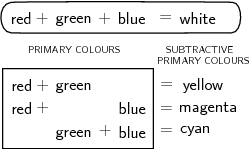| << Chapter < Page | Chapter >> Page > |

Aim:
To investigate the additive properties of colours and determine the complementary colours of light.
Apparatus:
You will need two battery operated torches with flat bulb fronts, a large piece of white paper, and some pieces of cellophane paper of the following colours: red, blue, green, yellow, cyan, magenta. (You should easily be able to get these from a newsagents.)
Make a table in your workbook like the one below:
| Colour 1 | Colour 2 | Final colour prediction | Final colour measured |
| red | blue | ||
| red | green | ||
| green | blue | ||
| magenta | green | ||
| yellow | blue | ||
| cyan | red |
Before you begin your experiment, use what you know about colours of light to write down in the third column "Final colour prediction", what you think the result of adding the two colours of light will be. You will then be able to test your predictions by making the following measurements:
Method:
Proceed according to the table above. Put the correct colour of cellophane paper over each torch bulb. e.g. the first test will be to put red cellophane on one torch and blue cellophane on the other. Switch on the torch with the red cellophane over it and shine it onto the piece of white paper.
What colour is the light?
Turn off that torch and turn on the one with blue cellophane and shine it onto the white paper.
What colour is the light?
Now shine both torches with their cellophane coverings onto the same spot on the white paper. What is the colour of the light produced? Write this down in the fourth column of your table.
Repeat the experiment for the other colours of cellophane so that you can complete your table.
Questions:
Complementary colours are two colours of light which add together to give white.
Complementary colours are two colours which add together to give white. Place a tick in the box where the colours in the first column added to the colours in the top row give white.
| magenta | yellow | cyan | |
| (=red+blue) | (=red+green) | (=blue+green) | |
| red | |||
| green | |||
| blue |
You should have found that the complementary colours for red, green and blue are:
The light-sensitive lining on the back inside half of the human eye is called the retina. The retina contains two kinds of light sensitive cells or photoreceptors : the rod cells (sensitive to low light) and the cone cells (sensitive to normal daylight) which enable us to see. The rods are not sensitive to colour but work well in dimly lit conditions. This is why it is possible to see in a dark room, but it is hard to see any colours. Only your rods are sensitive to the low light levels and so you can only see in black, white and grey. The cones enable us to see colours.Normally, there are three kinds of cones, each containing a different pigment. The cones are activated when the pigments absorb light. The three types of cones are sensitive to (i.e. absorb) red, blue and green light respectively. Therefore we can perceive all the different colours in the visible spectrum when the different types of cones are stimulated by different amounts since they are just combinations of the three primary colours of light.
The rods and cones have different response times to light. The cones react quickly when bright light falls on them. The rods take a longer time to react. This is why it takes a while (about 10 minutes) for your eyes to adjust when you enter a dark room after being outside on a sunny day.
When blue and green light fall on an eye, is cyan light being created? Discuss.
Cyan light is not created when blue and green light fall on the eye. The blue and green receptors are stimulated to make the brain believe that cyan light is being created.
If you look very closely at a colour cathode-ray television screen or cathode-ray computer screen, you will see that there are very many small red, green and blue dots called phosphors on it. These dots are caused to fluoresce (glow brightly) when a beam of electrons from the cathode-ray tube behind the screen hits them. Since different combinations of the three primary colours of light can produce any other colour, only red, green and blue dots are needed to make pictures containing all the colours of the visible spectrum.

Notification Switch
Would you like to follow the 'Siyavula textbooks: grade 12 physical science' conversation and receive update notifications?